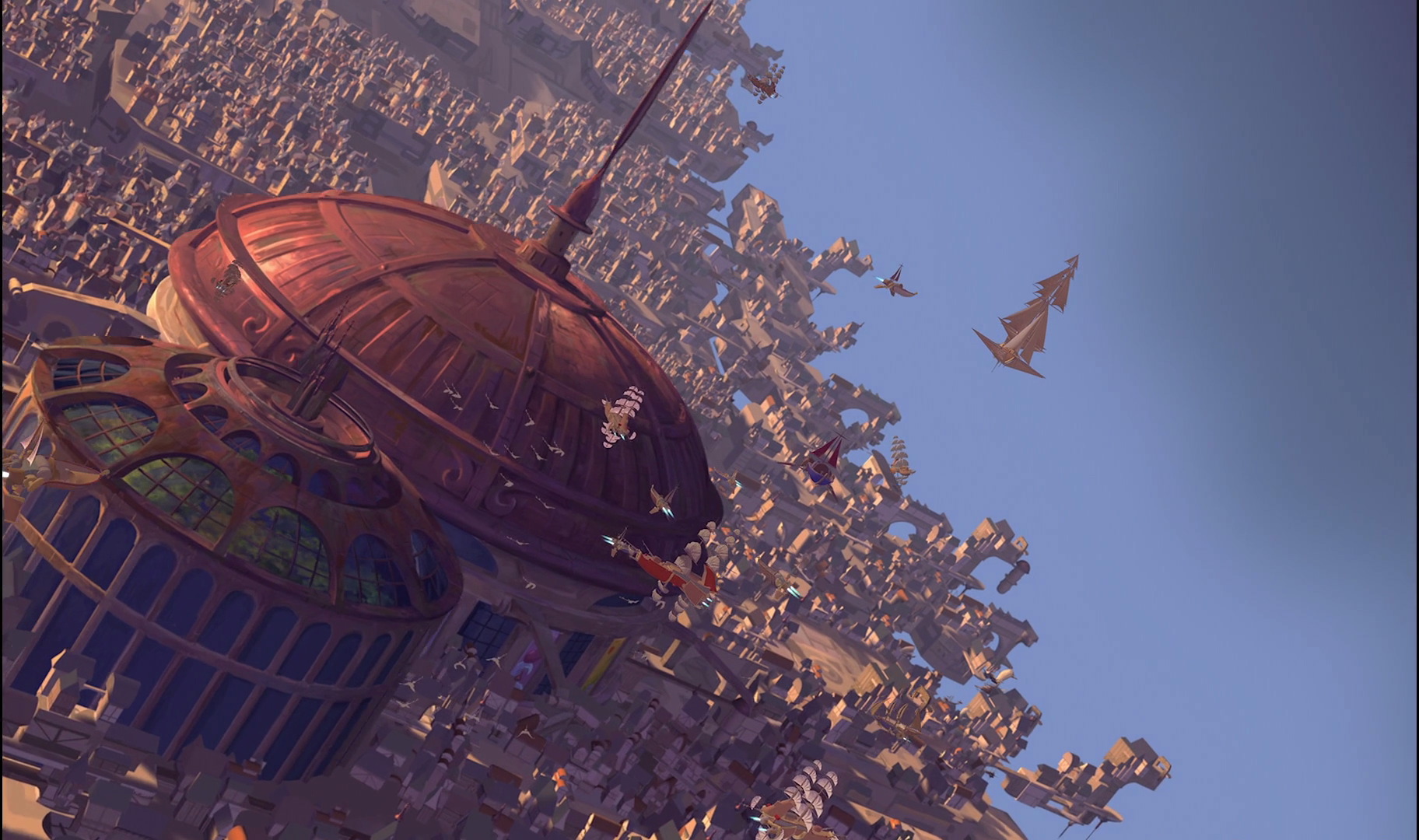A look at Musker and Clements’s much-maligned masterpiece.
Last week, the Wreck-It Ralph 2 trailer arrived, and with it, Disney dove headfirst into the wide, wicked world of shameless self-promotion. Sure, the basic “jokes about the internet” are present, but Wreck-It Ralph is bringing in the big guns: The Disney Princesses, those omnipresent bastions of a time long gone, a time when Disney stood for magical kingdoms and fairy stories for misty-eyed children. The Disney Princesses, a symbol of the days of traditional animation that elevated the name of Walt Disney to immortality!
But if we’re talking about traditional animation, I have one question: Where is the Treasure Planet representation?

Walt Disney Animation Studios
Disney is pulling out all the stops with its self-promotion. This trailer has got Iron Man and stormtroopers in it, properties that Disney proper rarely slaps its label on because it doesn’t want everyone to realize it owns everything just yet. And despite that, in a trailer that showcases everything Disney has to offer, one of its greatest storytelling and technical achievements is swept under the rug. And I must ask, why?
Treasure Planet, released in 2002, was a technical masterpiece and the love child of John Musker and Ron Clements, a pair of Mouse House veterans who directed Disney Renaissance masterpieces like The Little Mermaid (1989), Aladdin (1992), and Hercules (1997). The film is a masterful retelling of Robert Louis Stevenson’s Treasure Island, except, well, it’s in space and it’s amazing. Musker and Clements reimagine the ocean as a vast and beautiful cosmos, waiting to be explored by dashing rogues like those that would become popular (some would say too popular) with Disney’s later live-action Pirates of the Caribbean franchise.
Not only is the art and animation absolutely stunning, the writing actually does Treasure Island better than Treasure Island! In the original work, Jim Hawkins is just a kid off on an adventure that happens to get overtaken by pirates, but by characterizing him as an angst-ridden teen (voiced by a young Joseph Gordon-Levitt! Bet you didn’t expect that one) with daddy issues, Musker and Clements add emotional weight to Treasure Island’s big twist. There’s a lot more emotion in the betrayal when Silver betrays Jim in Treasure Planet because by the time he does, he has become a father figure to our young protagonist.
Furthermore, the film is an accomplishment of technology, notable for its usage of Deep Canvas. This neat little piece of tech, first notable in Tarzan (1999), allowed animators to create huge 3D environments, move the camera through them, and then draw animation on top of that, creating an astounding and immersive effect and allowing for insanely cool camera moves. Treasure Planet utilizes Deep Canvas throughout; the ship, which is the main setting for the film, was made entirely in the software.

Walt Disney Animation Studios
So Treasure Planet is basically the best Disney animated film to come out since the turn of the millennium and I will fight you if you suggest otherwise. But why am I the only one talking about it? Why am I the only one who seems to remember it? The answer may not surprise you: It’s money, dear boy.
In the seven years prior to Treasure Planet, Pixar had released four films, all of which were explosively popular. The public was clamoring for more full 3D animation. 2D was not only out of style, it was expensive. To make more movies like Treasure Planet, the studio would not only have to invest further in an unpopular medium, they would have to pay expensive technicians to run specialized software like Deep Canvas, not to mention the wages of all those 2D artists.
Added to this was the complication that Treasure Planet already had a sequel in the works. Treasure Planet was so prohibitively expensive to make that even if it succeeded, it likely would have represented a financial loss for Disney. But if Treasure Planet was popular with audiences, it wouldn’t matter how unprofitable the film was, money would have to be spent to make Treasure Planet 2. The easiest thing for Disney to do from a financial standpoint was to let Treasure Planet flop and then go straight-up Voldemort on the baby Treasure Planet 2.
And that’s a real shame. Treasure Planet is a showcase of the amazing things that can be done by mixing mediums and experimenting with new technology. Traditional animation lives on today on the internet and anime, but most of its practitioners are preservers of an old art, and traditional animation studios make most of their content in the form of promotional trailers for video games. Traditional animation doesn’t get big budgets to play with new technology and push the boundaries anymore, and that’s kind of sad. Disney was the last studio with both the financial capital and the motive to keep doing this kind of work.
After the financial flop that was Sleeping Beauty in 1959, Walt Disney almost shut down the animation department of his company for good, given how expensive it was to run. But he continued on because traditional animation had been the foundation of his studio from the beginning, experimentation further so. Walt Disney was the man who brought sound and color to cartoons and decided that they were worth making into features. I wonder what he would think of his studio purposely shutting down innovation and experimentation in the name of profit, 36 years after his death.
The post Why Aren’t We Still Talking About ‘Treasure Planet’? appeared first on Film School Rejects.
No comments:
Post a Comment